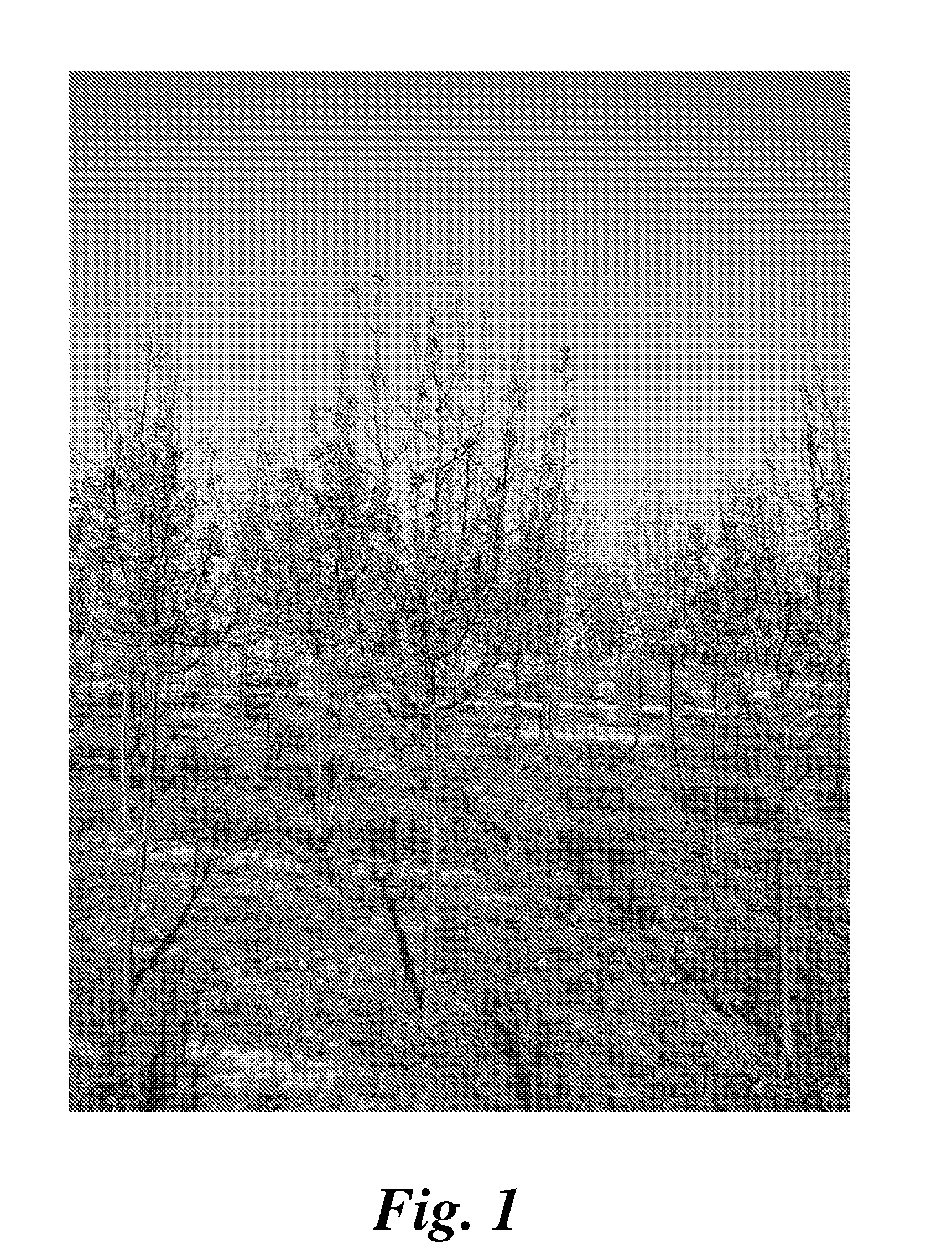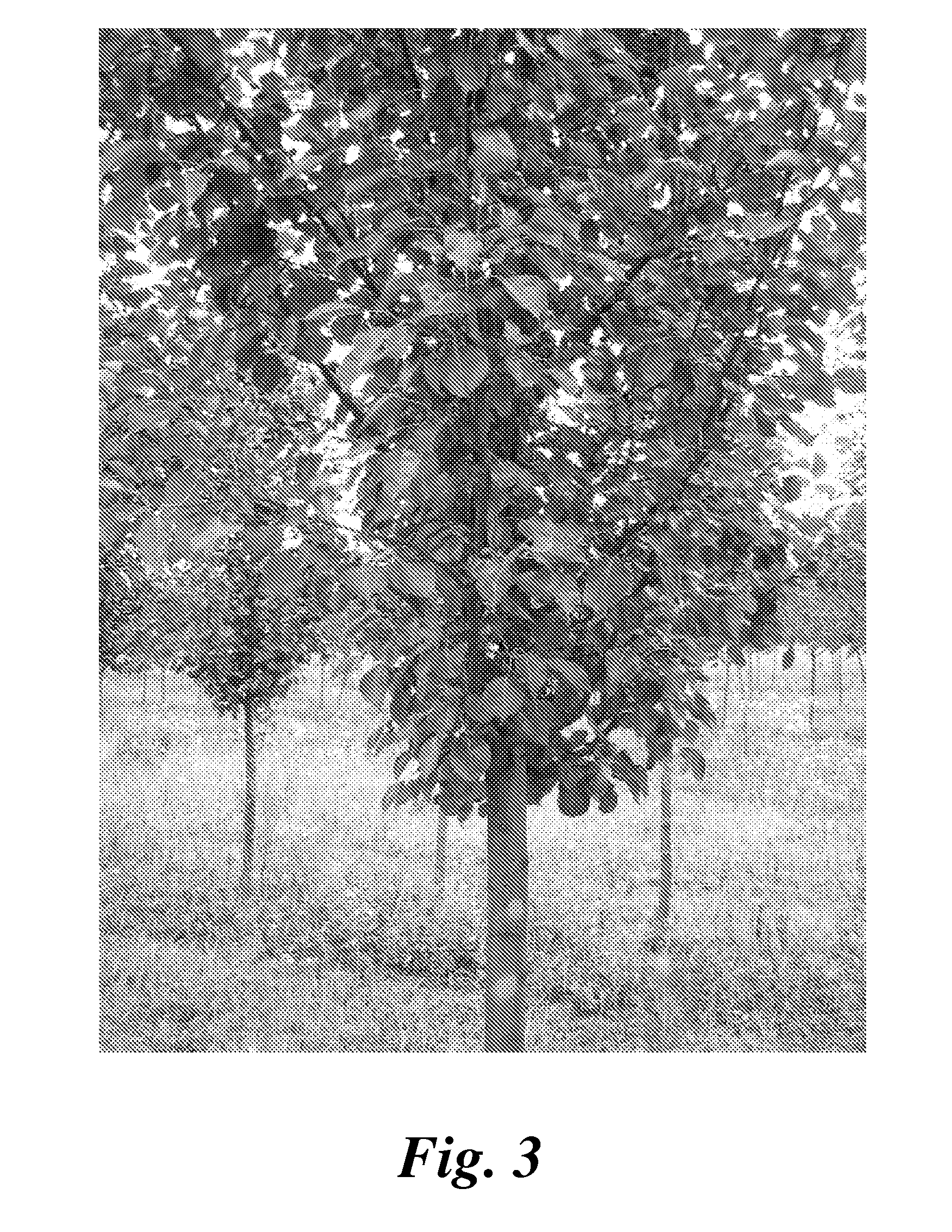Formulation and method for treating plants to control or suppress a plant pathogen
- Summary
- Abstract
- Description
- Claims
- Application Information
AI Technical Summary
Benefits of technology
Problems solved by technology
Method used
Image
Examples
example 1
Testing the Efficacy of Applying Beneficial Microorganisms and Nutrients Generally Applied to the Roots of a Plant to the Above Ground Structures of the Plant as a Method for Suppressing Fire Blight in Pear Trees
[0085] A test plot was selected in east-central Indiana (U.S.A). The test plot included 17 rows of pear trees of differing species. The first 4 rows contained Cambridge pear trees. These trees had previously been exposed to Erwinia amylovora, the species of bacteria that causes fire blight. About 67% of the trees had been infected; about half of the infected trees died. The test plot included surviving trees adjacent to the infected dead trees. The next 2 rows were Autumn Blaze pear trees. These trees had about a 15% infection rate with a mortality rate of 8%. The next 7 rows were Aristocrat pear trees, a variety which is highly-susceptible to fire blight. The Aristocrat pear trees had about a 15% infection rate from the previous year. These trees were larger than the other...
example2
Formulation in Accordance with One Embodiment Useful for the Control of Plant Pathogens Including Fire Blight
[0094]
TABLE 2Elemental Analysis% by weight 1. Total Nitrogen (N)3 2. Soluble Potassium (K2O)20 3. Iron, Chelated (Fe)7 4. Sulfur (5) Combined4 5. Water Soluble Magnesium (Mg)1.5 6. Manganese, Chelated (Mn)0.2 7. Water Soluble Boron (B)0.02 8. Zinc, Chelated (Zn)0.2 9. Calcium glucoheptonate510. Beneficial Bacteria833 million cfu / lb11. Non-plant food ingredients
[0095]
TABLE 3Listing of Beneficial Bacteria and FungiMillion cfu / lb1. Bacillus licheniformis8332. Bacillus megaterium8333. Bacillus polymyxa8334. Bacillus subtilis8335. Bacillus thuringiensis8336. Paenibacillus azotofixans8337. Streptomyces griseoviridis18. Trichoderma harzianum109. Trichoderma konigii10
[0096]
TABLE 4Listing of Nutrients% by weight1. Humic acids3.52. Cold Water Sea Kelp Extract43. Soluble Yucca Plant Extractup to 124. Maltodextrinup to 8 5. Sugar (Dextrose)up to 126. Yeast5
example 3
A Preferred Formulation in Accordance with One Embodiment, Useful for the Control and Suppression of Plant Pathogens
[0097] A formulation for the control or suppression of plant pathogens including fire blight was prepared including the compounds listed in Table 5. Whenever pome fruit trees such as Apple or Pear trees are treated Tricoderma and Bacillus licheniformis can be removed from the formulation.
[0098] This formulation and variations thereof were used to treat trees and shrubs in an orchard and nursery near Dayton, Ohio (USA). The results of these tests are described in the following Examples.
TABLE 5Stock solution for direct application includes unless noted otherwise.Unless otherwise noted to one hundred gallons of water was added the following:AmountDescription45 gramsdried inactive Sacchromyces cervisiae (yeast)45 gramscalcium glucoheptonate¼ pounda mixture of microorganisms from Mycroohizal Application Inc.,Grants Pass Oregon which includes:(1.1 Billion cfu per pound t...
PUM
 Login to View More
Login to View More Abstract
Description
Claims
Application Information
 Login to View More
Login to View More - R&D
- Intellectual Property
- Life Sciences
- Materials
- Tech Scout
- Unparalleled Data Quality
- Higher Quality Content
- 60% Fewer Hallucinations
Browse by: Latest US Patents, China's latest patents, Technical Efficacy Thesaurus, Application Domain, Technology Topic, Popular Technical Reports.
© 2025 PatSnap. All rights reserved.Legal|Privacy policy|Modern Slavery Act Transparency Statement|Sitemap|About US| Contact US: help@patsnap.com



